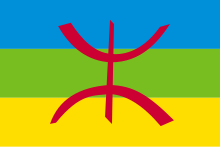ชนเบอร์เบอร์
Imaziɣen, ⵉⵎⴰⵣⵉⵖⵏ, ⵎⵣⵗⵏ | |
|---|---|
 ธงชาติพันธุ์เบอร์เบอร์ | |
| ประชากรทั้งหมด | |
| 20–30 ล้าน[1][2][3] – 50 ล้านคน[4] | |
| ภูมิภาคที่มีประชากรอย่างมีนัยสำคัญ | |
| โมร็อกโก | ตั้งแต่ ≈ 10 ล้าน[2] ถึง ≈ 12 ล้าน[5][6][7] |
| แอลจีเรีย | จาก 9[2] ถึง ≈ 13 ล้าน[7][8] |
| ลิเบีย | ~3,850,000[4] |
| ตูนิเซีย | 110,000[9] ถึง ≈ 389,652[4] |
| ฝรั่งเศส | มากกว่า 2 ล้าน[10] |
| มอริเตเนีย | 2,883,000 (2,768,000[11] & 115,000[12]) |
| ไนเจอร์ | 1,620,000[13] |
| มาลี | 850,000[14] |
| เบลเยียม | 500,000 (รวมลูกหลาน)[15] |
| เนเธอร์แลนด์ | 367,455 (รวมลูกหลาน)[ต้องการอ้างอิง] |
| บูร์กินาฟาโซ | 50,000[16] |
| อียิปต์ | 34,000[17] or 1,826,580[4] |
| แคนาดา | 37,060 (รวมลูกครึ่ง)[18] |
| อิสราเอล | 3,500[19] |
| สหรัฐ | 1,327[20] |
| ภาษา | |
| ภาษาเบอร์เบอร์ (ทามาไซต์) มักเขียนกับอักษรทิฟินาค, Berber Latin alphabet; Maghrebi Arabic dialects (among Arabized Berbers) | |
| ศาสนา | |
| ส่วนใหญ่นับถืออิสลามนิกายซุนนี. ส่วนน้อยนับถือนิกายอื่น (ชีอะฮ์, อิบาดี), ศาสนาคริสต์ (โปรเตสแตนต์),[21][22] ศาสนายูดาย และความเชื่อดั้งเดิม | |
| กลุ่มชาติพันธุ์ที่เกี่ยวข้อง | |
| กลุ่นแอโฟรเอชีแอติก[23][24][25][26][27][28][29] | |
ชนเบอร์เบอร์ (อังกฤษ: Berber people) เป็นกลุ่มชาติพันธ์ของแอฟริกาเหนือทางตะวันตกของลุ่มแม่น้ำไนล์ ผู้ที่ตั้งถิ่นฐานกระจัดกระจายอยู่ในบริเวณตั้งแต่มหาสมุทรแอตแลนติกไปจนถึงโอเอซิสซิวา (Siwa oasis) ในอียิปต์ และจากบริเวณเมดิเตอร์เรเนียนไปจนถึงแม่น้ำไนเจอร์ ในประวัติศาสตร์ชนเบอร์เบอร์พูดภาษากลุ่มเบอร์เบอร์ซึ่งเป็นสาขาหนึ่งของตระกูลภาษาแอโฟรเอชีแอติก ในปัจจุบันชนเบอร์เบอร์บางกลุ่มพูดภาษาอาหรับ ชนเบอร์เบอร์ที่พูดภาษากลุ่มเบอร์เบอร์ในบริเวณที่ว่านี้มีด้วยกันราว 30 ถึง 40 ล้านคนที่ส่วนใหญ่ตั้งถิ่นฐานหนาแน่นอยู่ในบริเวณแอลจีเรียและโมร็อกโก และเบาบางลงไปทางตะวันออกไปทางมาเกรบ (Maghreb) และเลยไปจากนั้น

ชนเบอร์เบอร์เรียกตนเองด้วยชื่อต่าง ๆ ที่รวมทั้ง “Imazighen” (เอกพจน์ “Amazigh”) ที่อาจจะแปลว่า “ชนอิสระ” ตามความเห็นของนักการทูตและนักประพันธ์ชาวอาหรับเลโอ อาฟริคานัส “Amazigh” แปลว่า “คนอิสระ” แต่ความเห็นนี้ก็ยังเป็นที่โต้แย้งกันเพราะไม่มีรากของความหมายของ “M-Z-Gh” ที่แปลว่า “อิสระ” ในภาษากลุ่มเบอร์เบอร์สมัยใหม่ นอกจากนั้นก็ยังมีคำภาษา Tuareg “amajegh” ที่แปลว่า “ศักดิ์ศรี” (noble)[30][31] คำเรียกนี้ใช้กันทั่วไปในโมร็อกโก แต่ในบริเวณอื่นในท้องถิ่นก็มีคำอื่นที่เฉพาะเจาะจงลงไปอีกเช่น “Kabyle” หรือ “Chaoui” ที่มักจะใช้กันมากกว่า[32] ในประวัติศาสตร์ชนเบอร์เบอร์ก็รู้จักกันในชื่อต่างๆ เช่นในลิเบียโบราณโดยชาวกรีกโบราณ[33] ว่า “นูมิเดียน” และ “มอเนเทเนีย” โดยโรมัน และ “มัวร์” โดยชายยุโรปในยุคกลาง ภาษาอังกฤษสมัยปัจจุบันอาจจะแผลงมาจากภาษาอิตาลีหรืออาหรับแต่รากที่ลึกไปกว่านั้นไม่เป็นที่ทราบ
ชาวเบอร์เบอร์ที่มีชื่อเสียงเป็นที่รู้จักกันก็ได้แก่นักประพันธ์ชาวโรมันอพูเลียส (Apuleius), จักรพรรดิโรมันเซ็พติมิอัส เซเวอรัส และ นักบุญออกัสตินแห่งฮิปโป[34] ชาวเบอร์เบอร์ที่มีชื่อเสียงในปัจจุบันคือดารานักฟุตบอลซีเนอดีน ซีดาน
อ้างอิง
[แก้]- ↑ Native Peoples of the World: An Encyclopedia. Ed. Steven L. Danver, M. E. Sharpe/Mesa Verde Publishing, 2013, p. 23f.
- ↑ 2.0 2.1 2.2 "Berber people". สืบค้นเมื่อ 2016-08-17.
- ↑ "North Africa's Berbers get boost from Arab Spring". Fox News. 5 May 2012. สืบค้นเมื่อ 8 December 2013.
- ↑ 4.0 4.1 4.2 4.3 Tej K. Bhatia, William C. Ritchie (2006). The Handbook of Bilingualism. John Wiley & Sons. p. 860. ISBN 0631227350. สืบค้นเมื่อ 16 July 2016.
((cite book)): CS1 maint: uses authors parameter (ลิงก์) - ↑ อ้างอิงผิดพลาด: ป้ายระบุ
<ref>ไม่ถูกต้อง ไม่มีการกำหนดข้อความสำหรับอ้างอิงชื่อminorityrights.org - ↑ Peter Prengaman: Morocco's Berbers Battle to Keep From Losing Their Culture / Arab minority forces majority to abandon native language, Chronicle Foreign Service, March 16, 2001, on sfgate.com.
- ↑ 7.0 7.1 อ้างอิงผิดพลาด: ป้ายระบุ
<ref>ไม่ถูกต้อง ไม่มีการกำหนดข้อความสำหรับอ้างอิงชื่อaxl.cefan.ulaval.ca - ↑ "Algeria reinstates term limit and recognises Berber language". BBC News.
- ↑ "Tunisia". The World Factbook.[ลิงก์เสีย]
- ↑ Les langues de France : un patrimoine méconnu, une réalité vivante เก็บถาวร 2014-09-29 ที่ เวย์แบ็กแมชชีน, originally published by CultureComm unication.gouv.fr.
- ↑ Scholastic Library Publishing (2005). Lands and Peoples: Africa. Grolier. p. 135. ISBN 0717280241. สืบค้นเมื่อ 17 August 2016.; Moors 80% of population of 3,460,000
- ↑ Joshua Project. "Tuareg, Tamasheq in Mauritania".
- ↑ "Niger". The World Factbook. คลังข้อมูลเก่าเก็บจากแหล่งเดิมเมื่อ 2020-04-24. สืบค้นเมื่อ 2019-08-22.
- ↑ "Mali". The World Factbook. คลังข้อมูลเก่าเก็บจากแหล่งเดิมเมื่อ 2015-11-10. สืบค้นเมื่อ 2019-08-22.
- ↑ Truong, Nicolas (2016-03-23). "Au cœur des réseaux djihadistes européens, le passé douloureux du Rif marocain". Le Monde.fr (ภาษาฝรั่งเศส). ISSN 1950-6244. สืบค้นเมื่อ 2016-11-16.
- ↑ Joshua Project. "Tuareg, Tamasheq in Burkina Faso".
- ↑ Joshua Project. "Berber, Siwa in Egypt".
- ↑ Government of Canada, Statistics Canada (February 8, 2017). "Census Profile, 2016 Census - Canada [Country] and Canada [Country]". www12.statcan.gc.ca.
- ↑ Moshe Shokeid: The Dual Heritage: Immigrants from the Atlas Mountains in an Israeli Village. Manchester University Press, 1971.
- ↑ US Census Bureau. "The Arab Population: 2000" (PDF). สืบค้นเมื่อ 2013-05-05.
- ↑ Sadek Lekdja: Christianity in Kabylie, Radio France Internationale, 7 mai 2001 เก็บถาวร 2017-10-18 ที่ เวย์แบ็กแมชชีน. "Believers in Christ from a Muslim Background: A Global Census | Duane A Miller Botero - Academia.edu". academia.edu. สืบค้นเมื่อ 27 March 2016.
- ↑ *(ฝรั่งเศส)
- ↑ Blench, Roger. Archaeology, Language, and the African Past. Rowman: Altamira, 2006 ISBN 9780759104662
- ↑ Diakonoff, Igor. The Earliest Semitic Society: Linguistic Data. Journal of Semitic Studies, Vol. 43 Iss. 2 (1998).
- ↑ Shirai, Noriyuki. The Archaeology of the First Farmer-Herders in Egypt: New Insights into the Fayum Epipalaeolithic and Neolithic. Leiden University Press, 2010. ISBN 9789087280796.
- ↑ Blench R (2006) Archaeology, Language, and the African Past, Rowman Altamira, ISBN 0-7591-0466-2, ISBN 978-0-7591-0466-2, books.google.be/books?id=esFy3Po57A8C
- ↑ Ehret C, Keita SOY, Newman P (2004) The Origins of Afroasiatic a response to Diamond and Bellwood (2003) in the Letters of SCIENCE 306, no. 5702, p. 1680 doi:10.1126/science.306.5702.1680c
- ↑ Bender ML (1997), Upside Down Afrasian, Afrikanistische Arbeitspapiere 50, pp. 19–34
- ↑ Militarev A (2005) Once more about glottochronology and comparative method: the Omotic-Afrasian case, Аспекты компаративистики – 1 (Aspects of comparative linguistics – 1). FS S. Starostin. Orientalia et Classica II (Moscow), p. 339-408. http://starling.rinet.ru/Texts/fleming.pdf เก็บถาวร 2020-12-07 ที่ เวย์แบ็กแมชชีน
- ↑ Brett, M. (1996). The Berbers. Blackwell Publishing. pp. 5–6.
((cite book)): ไม่รู้จักพารามิเตอร์|coauthors=ถูกละเว้น แนะนำ (|author=) (help) - ↑ Maddy-weitzman, B. (2006). "Ethno-politics and globalisation in North Africa: The berber culture movement*" (PDF). The Journal of North African Studies. 11 (1): 71–84. doi:10.1080/13629380500409917. สืบค้นเมื่อ 2007-07-17.
- ↑ Mohand Akli Haddadou, Le guide de la culture berbère, Paris Méditerranée, 2000, p.13-14
- ↑ Brian M. Fagan, Roland Oliver, Africa in the Iron Age: c 500 BCE to 1400 CE p. 47
- ↑ Encyclopedia Americana, Scholastic Library Publishing, 2005, v.3, p.569
Text is available under the CC BY-SA 4.0 license; additional terms may apply.
Images, videos and audio are available under their respective licenses.
